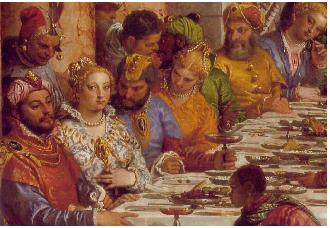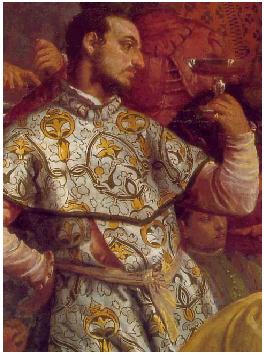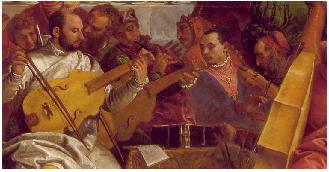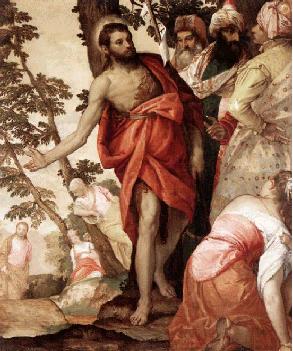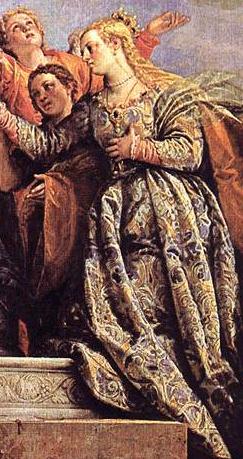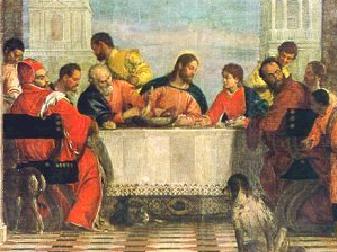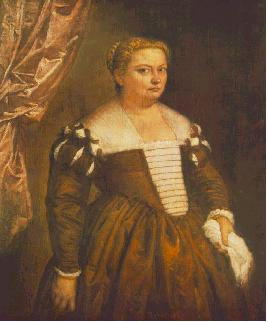
Candida Martinelli's Italophile Site

Main
Page This family-friendly site celebrates Italian culture for the enjoyment of children and
adults. Site-Overview
Knights of Art -
Paul Veronese
Visit
my Angels in Italian Art Page
Visit
my Canaletto and Venice Art Page On-line images of art at Web
Gallery of Art: It
was in the city of Verona that Paul Cagliari, the last of the great
painters of the Venetian school, was born. The name of that old city of
the Veneto makes us think at once of moonlight nights and fair Juliet
gazing from her balcony as she bids farewell to her dear Romeo. For it
was here that the two lovers lived their short lives which ended so
sadly. But
Verona has other titles to fame besides being the scene of Shakespeare's
story, and one of her proudest boasts is that she gave her name to the
great Venetian artist Paolo Veronese, or Paul of Verona, as we would say
in English. Marriage at Cana (detail) by
Veronese There
were many artists in Verona when Paolo was a boy. His own father was a
sculptor and his uncle a famous painter, so the child was encouraged to
begin work early. As soon as he showed that he had a talent for
painting, he was sent to his uncle's studio to be taught his first
lessons in drawing. Marriage at Cana (detail) by
Veronese Verona
was not very far off from Venice, and Paolo was never tired of listening
to the tales told of that beautiful Queen of the Sea. He loved to try
and picture her magnificence, her marble palaces overlaid with gold, her
richly-dressed nobles, and, above all, the wonder of those pictures
which decked her walls. The very names of Giorgione and Titian sounded
like magic in his ears. They seemed to open out before him a wonderful
new Paradise, where stately men and women clad in the richest robes
moved about in a world of glowing colour. At
last the day came when he was to see the city of his dreams, and enter
into that magic world of Art. What delight it was to study those
pictures hour by hour, and learn the secrets of the great masters. It
was the best teaching that heart could desire. Marriage at Cana (detail) by
Veronese No
one in Venice took much notice of the quiet, hard-working young painter,
and he worked on steadily by himself for some years. But at last his
chance came, and he was commissioned to paint the ceiling of the church
of St. Sebastian; and when this was finished Venice recognised his
genius, and saw that here was another of her sons whom she must delight
to honour. These
great pictures of Veronese were just the kind of work to charm the rich
Venetians, those merchant princes who delighted in costly magnificence.
Never before had any painter pictured such royal scenes of grandeur.
There were banqueting halls with marble balustrades just like their own
Venetian palaces. The guests that thronged these halls were courtly
gentlemen and high-born ladies arrayed in rich brocades and dazzling
jewels. Men- servants and maidservants, costly ornaments and golden
dishes were there, everything that heart could desire. St. John the Baptist Preaching
by Veronese
True,
there was not much room for religious feeling amid all this grandeur,
although the painter would call the pictures by some Bible name and
would paint in the figure of our Lord, or the Blessed Virgin, among the
gay crowd. But no one stopped to think about religion, and what cared
they if the guests at the `Marriage Feast of Cana' were dressed in the
rich robes of Venetian nobles, and all was as different as possible from
the simple wedding-feast where Christ worked his first miracle. So
the fame of Paolo Veronese grew greater and greater, and he painted more
and more gorgeous pictures. But here and there we find a simpler and
more charming piece of his work, as when he painted the little St. John
with the skin thrown over his bare shoulder and the cross in his hand.
He is such a really childlike figure as he stands looking upward and
rests his little hand confidingly on the worn and wounded palm of St.
Francis, who stands beside him. Marriage of St. Catherine
(detail) by Veronese Although
the Venetian nobles found nothing wanting in the splendid pictures which
Veronese painted, the Church at last began to have doubts as to whether
they were fit as religious subjects to adorn her walls. The Holy Office
considered the question, and Veronese was ordered to appear before the
council. Was
it, indeed, fit that court jesters, and even cats and
pet dogs should appear in pictures which were to decorate the walls of a
church? Veronese answered gravely that it was the effect of the picture
that mattered, and that the details need not be thought of. So the
complaint was dismissed. Feast at the House of the Levi
(detail) by Veronese These
pictures of Paolo Veronese were really great pieces of decoration, very
wonderful in their way, but showing already that religious art was sinking lower
instead of rising higher. If
the spirits of the old masters could have returned to gaze upon this new
work, what would their feelings have been? How the simple Giotto would
have shaken his head over this wealth of ornament which meant so little,
even while he marvelled at the clever work. How sorrowfully would Fra
Angelico have turned away from this perfection of worldly vanity, and
sighed to think that the art of painting was no longer a golden chain to
link men's souls to Heaven. Even the merry-hearted monk Fra Filippo
Lippi would scarce have approved of all this gorgeous company. Portrait of a Venetian Woman
by Veronese Art
had indeed shaken off the binding rules of old tradition, and Veronese
was free to follow his own magnificent fancy. But who can say if that
freedom was indeed a gain? And it is with a sigh that we close the
record of Italian Art and turn our eyes, wearied with all its splendour
and the glare of the noonday sun, back to the early dawn, when the soul
of the painter looked through his pictures, and taught us the simple
lesson that work done for the glory of God was greater than that done
for the praise of men.
Return to:
Stories of the Italian Painters
by Amy Steedman
